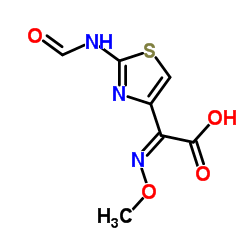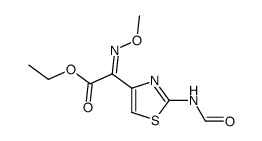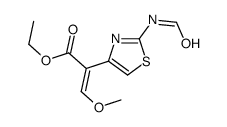2-(2-Formamidothiazole-4-yl)-2-methoxyimino acetic acid
Modify Date: 2025-08-21 22:36:50

2-(2-Formamidothiazole-4-yl)-2-methoxyimino acetic acid structure
|
Common Name | 2-(2-Formamidothiazole-4-yl)-2-methoxyimino acetic acid | ||
|---|---|---|---|---|
| CAS Number | 65872-43-7 | Molecular Weight | 229.213 | |
| Density | 1.6±0.1 g/cm3 | Boiling Point | 438.5±55.0 °C at 760 mmHg | |
| Molecular Formula | C7H7N3O4S | Melting Point | 163 °C (dec.)(lit.) | |
| MSDS | Chinese USA | Flash Point | 219.0±31.5 °C | |
| Symbol |

GHS07 |
Signal Word | Warning | |
| Name | 2-(2-Formamidothiazole-4-yl)-2-methoxyimino acetic acid |
|---|---|
| Synonym | More Synonyms |
| Density | 1.6±0.1 g/cm3 |
|---|---|
| Boiling Point | 438.5±55.0 °C at 760 mmHg |
| Melting Point | 163 °C (dec.)(lit.) |
| Molecular Formula | C7H7N3O4S |
| Molecular Weight | 229.213 |
| Flash Point | 219.0±31.5 °C |
| Exact Mass | 229.015732 |
| PSA | 129.12000 |
| LogP | 0.05 |
| Vapour Pressure | 0.0±1.1 mmHg at 25°C |
| Index of Refraction | 1.664 |
| InChIKey | NRRJNSWNWIDHOX-YHYXMXQVSA-N |
| SMILES | CON=C(C(=O)O)c1csc(NC=O)n1 |
| Storage condition | 2-8°C |
Synonym: SECTION 2 - COMPOSITION, INFORMATION ON INGREDIENTS
Hazard Symbols: XI SECTION 3 - HAZARDS IDENTIFICATION EMERGENCY OVERVIEW Irritating to eyes, respiratory system and skin.The toxicological properties of this material have not been fully investigated.Moisture sensitive. Potential Health Effects Eye: Causes eye irritation. Skin:
Causes skin irritation. Ingestion: May cause gastrointestinal irritation with nausea, vomiting and diarrhea. The toxicological properties of this substance have not been fully investigated. Inhalation: Causes respiratory tract irritation. Chronic: No information found. SECTION 4 - FIRST AID MEASURES Eyes: Flush eyes with plenty of water for at least 15 minutes, occasionally lifting the upper and lower eyelids. Get medical aid. Skin: Get medical aid. Flush skin with plenty of water for at least 15 minutes while removing contaminated clothing and shoes. Ingestion: Get medical aid. Wash mouth out with water. Inhalation: Remove from exposure and move to fresh air immediately. If not breathing, give artificial respiration. If breathing is difficult, give oxygen. Get medical aid. Notes to Physician: SECTION 5 - FIRE FIGHTING MEASURES General Information: As in any fire, wear a self-contained breathing apparatus in pressure-demand, MSHA/NIOSH (approved or equivalent), and full protective gear. Extinguishing Media: Use water spray, dry chemical, carbon dioxide, or chemical foam. SECTION 6 - ACCIDENTAL RELEASE MEASURES General Information: Use proper personal protective equipment as indicated in Section 8. Spills/Leaks: Vacuum or sweep up material and place into a suitable disposal container. SECTION 7 - HANDLING and STORAGE Handling: Avoid breathing dust, vapor, mist, or gas. Avoid contact with skin and eyes. Use only in a chemical fume hood. Storage: Store in a cool, dry place. Store in a tightly closed container. SECTION 8 - EXPOSURE CONTROLS, PERSONAL PROTECTION Engineering Controls: Facilities storing or utilizing this material should be equipped with an eyewash facility and a safety shower. Exposure Limits CAS# 65872-43-7: Personal Protective Equipment Eyes: Wear chemical splash goggles. Skin: Wear appropriate protective gloves to prevent skin exposure. Clothing: Wear a chemical apron. Respirators: A NIOSH/MSHA approved air purifying dust or mist respirator or European Standard EN 149. SECTION 9 - PHYSICAL AND CHEMICAL PROPERTIES Physical State: Solid Color: off-white Odor: Not available. pH: Not available. Vapor Pressure: Not available. Viscosity: Not available. Boiling Point: Not available. Freezing/Melting Point: 165 deg C Autoignition Temperature: Not available. Flash Point: Not available. Explosion Limits, lower: Not available. Explosion Limits, upper: Not available. Decomposition Temperature: Solubility in water: Specific Gravity/Density: Molecular Formula: C7H7N3O4S Molecular Weight: 229.18 SECTION 10 - STABILITY AND REACTIVITY Chemical Stability: Stable under normal temperatures and pressures. Conditions to Avoid: Incompatible materials. Incompatibilities with Other Materials: Strong oxidizing agents. Hazardous Decomposition Products: Carbon monoxide, irritating and toxic fumes and gases, carbon dioxide. Hazardous Polymerization: Has not been reported SECTION 11 - TOXICOLOGICAL INFORMATION RTECS#: CAS# 65872-43-7 unlisted. LD50/LC50: Not available. Carcinogenicity: 2-(2-formamidothiazole-4-yl)-2-methoxyimino acetic acid, 95% - Not listed by ACGIH, IARC, or NTP. SECTION 12 - ECOLOGICAL INFORMATION SECTION 13 - DISPOSAL CONSIDERATIONS Dispose of in a manner consistent with federal, state, and local regulations. SECTION 14 - TRANSPORT INFORMATION IATA Not regulated as a hazardous material. IMO Not regulated as a hazardous material. RID/ADR Not regulated as a hazardous material. SECTION 15 - REGULATORY INFORMATION European/International Regulations European Labeling in Accordance with EC Directives Hazard Symbols: XI Risk Phrases: R 36/37/38 Irritating to eyes, respiratory system and skin. Safety Phrases: S 24/25 Avoid contact with skin and eyes. WGK (Water Danger/Protection) CAS# 65872-43-7: No information available. Canada None of the chemicals in this product are listed on the DSL/NDSL list. CAS# 65872-43-7 is not listed on Canada's Ingredient Disclosure List. US FEDERAL TSCA CAS# 65872-43-7 is not listed on the TSCA inventory. It is for research and development use only. SECTION 16 - ADDITIONAL INFORMATION MSDS Creation Date: 9/02/1997 Revision #2 Date: 3/18/2003 The information above is believed to be accurate and represents the best information currently available to us. However, we make no warranty of merchantability or any other warranty, express or implied, with respect to such information, and we assume no liability resulting from its use. Users should make their own investigations to determine the suitability of the information for their particular purposes. In no way shall the company be liable for any claims, losses, or damages of any third party or for lost profits or any special, indirect, incidental, consequential or exemplary damages, howsoever arising, even if the company has been advised of the possibility of such damages. SECTION 16 - ADDITIONAL INFORMATION N/A |
| Symbol |

GHS07 |
|---|---|
| Signal Word | Warning |
| Hazard Statements | H315-H319-H335 |
| Precautionary Statements | P261-P305 + P351 + P338 |
| Personal Protective Equipment | dust mask type N95 (US);Eyeshields;Gloves |
| Hazard Codes | Xi: Irritant; |
| Risk Phrases | R36/37/38 |
| Safety Phrases | S26-S36 |
| RIDADR | NONH for all modes of transport |
| WGK Germany | 3 |
| HS Code | 2934100090 |
|
~% 
2-(2-Formamidot... CAS#:65872-43-7 |
| Literature: US4288436 A1, ; |
|
~% 
2-(2-Formamidot... CAS#:65872-43-7 |
| Literature: Perrone; Alpegiani; Giudici; et al. Journal of Heterocyclic Chemistry, 1984 , vol. 21, # 4 p. 1097 - 1111 |
| Precursor 2 | |
|---|---|
| DownStream 0 | |
| HS Code | 2934100090 |
|---|---|
| Summary | 2934100090 other compounds containing an unfused thiazole ring (whether or not hydrogenated) in the structure VAT:17.0% Tax rebate rate:9.0% Supervision conditions:none MFN tariff:6.5% General tariff:20.0% |
| (2Z)-[2-(formylamino)-1,3-thiazol-4-yl](methoxyimino)ethanoic acid |
| EINECS 265-958-6 |
| MFCD00010413 |
| 4-Thiazoleacetic acid, 2-(formylamino)-α-(methoxyimino)-, (αZ)- |
| (2Z)-(2-Formamido-1,3-thiazol-4-yl)(methoxyimino)acetic acid |
| N-Formyloxamidine Acid |
| 2-(2-Formamidothiazole-4-yl)-2-methoxyimino acetic acid |

